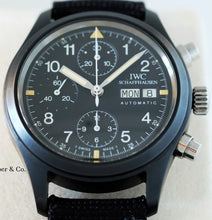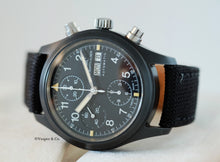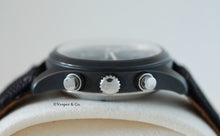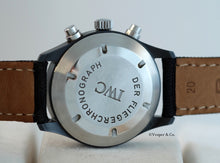
IWC. A Ceramic and Stainless Steel Automatic Chronograph Wristwatch with Day and Date
Model: Der Fliegerchronograph
Ref: 3705
Case No: 260xxxx
Circa: Mid-1990’s
Cal. 7902 automatic movement, black matte dial, Arabic numerals with luminous batons at 3, 6, and 9 and a luminous triangle at 12, luminous hands, outer minute divisions, three subsidiary dials for 12 hour and 30 minute registers and constant seconds, aperture for day in German and date at 3 o’clock, two round chronograph buttons in the band, ceramic case, stainless steel screw back, case, dial, and movement signed
39mm.
Accompanied by an IWC presentation box and papers
More about IWC:
The IWC reference 3705 Fliegerchronograph was the brand’s first ceramic chronograph. As seen with the IWC Aquatimer GST, IWC pioneered the use of alternative materials for case production. Today, the use of materials like titanium and ceramic are widespread, but at the time of their initial release, the use of these materials was incredibly innovative.
The ref. 3705 was launched in 1994 and only produced for three years. Less than 1000 examples were produced in total due to the high cost of making ceramic cases – 50% higher cost than that of a stainless steel example.
Despite the high cost, the use of zirconium oxide (commonly known as ceramic) in watch cases was appealing to IWC because it was extremely hard yet lightweight, and could be fused with other elements to provide additional hardness and scratch resistance. Ceramic is formed when a powder, a binder, and a liquid are combined and heated to temperatures over 1000 degrees Celsius. Unlike metals, ceramic pieces shrink by about a third after they are fired. Consequently, to use ceramic for something like a watch case, the measurements have to be extremely precise and the loss in size has to be factored in from the start.
The present watch is in mint condition and is an excellent opportunity for a watch aficionado to acquire an incredibly innovative watch model. While it was not produced as a limited edition watch, production of this model was extremely limited, making it hard to come by and extremely desirable.











